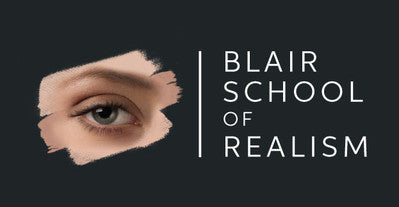There are many ways to learn how to paint, with each method having pros and cons. Here we will examine and compare methods of learning.
Most emerging artists give up out of frustration, and never attain their dreams of artistic excellence. Why? Because there is so much knowledge that is needed to gain command over the image, and it takes time to learn.

Self-Teaching
The first and most common method of learning is self-teaching. It involves a lot of trial and error, but mostly error. The person blindly tries different things, until stumbling across something that works, then onward to the next experiment. One advantage of this is that it doesn't cost any money. Another benefit, is the satisfaction associated with figuring it all out on your own. The disadvantage is that it is the slowest way to learn, and it will take many years (or even a lifetime) to figure out some things. Even then, its probably likely that you will unknowingly develop some bad habits that will cause problems for you later.
PRO: Free, learn at your own pace, satisfying pace for some people
CON: Knowledge comes slowly, over many years. high likelihood of developing bad habits

Books
There are quite a few good airbrush art books available, complete with photos and step-by-step text, all intended to guide the artist through the various creation processes. The benefit of a book, is that it is relatively inexpensive and can be read and revisited at your leisure. The downside is there is no interaction between you and the content. The photos don't move, and its one-sided conversation. Also, don't expect to have your mistakes or bad habits corrected.
PRO: Inexpensive. Knowledge comes slowly. Self-paced learning
CON: Static images. Often dated material. Zero instructor feedback

Magazines
While Magazines have the same static images and interaction limitations as books, the best magazines do have the advantage of access to cutting-edge trends and tools. However, because magazines generally feature a wider range of articles and material than books, they might contain less of what you are interested in reading. Because a subscription must be renewed in order to remain current, the long-term cost is a bit more than books or DVD's.
PRO: Inexpensive, latest innovations featured. Self-paced learning
CON: Static images. Knowledge comes slowly. Zero instructor feedback

DVD's and Video tapes
DVD's used to be quite popular, but over the past few years, they have lost ground to the popularity of YouTube and Vimeo. The movement of a video image allows you to more clearly understand the motions of the tools used by the instructor, while simultaneously hearing the explanation of their technique.The cost is slightly more than a book, but still relatively cheap. With the right instructor, a dedicated DVD is packed full of useful information.
The DVD or video tape is a physical object that is usually mailed to you, and requires you to purchase or own a player. As with books, there is no opportunity for feedback or corrections with DVDs or video instruction. You watch the movie, and do your best to imitate what you see. Unfortunately, there is little recourse if your tool doesn't perform in the same manner in which you witness on the screen. Like books, the material can become quickly dated, as new technologies, materials, and methods emerge.
PRO: Moving images convey material more clearly than books or magazines. Self-paced learning. reasonably priced.
CON: Requires DVD player. Knowledge comes slowly. Zero instructor feedback. Content not usually on the cutting edge of new products.
On line Videos
Videos on YouTube and Vimeo are one of the most popular learning tools these days. Prices vary from free to expensive subscription-based channels. Knowledge is literally at your fingertips, and beginning artists will find some good information available. Online videos suffer the same absence of interaction with the instructor as DVD's and books. The communication is one-way.
PRO: moving images convey material more clearly. Knowledge comes slowly. Self-paced learning
CON: requires computer, Zero instructor feedback

Live streaming and online video instruction
Social media has provided a mechanism for presenting information in real-time. Some instructors offer free seminars, whereas others charge a premium for their virtual classroom. Through text messages, you can post questions to the instructor, which allows some degree of feedback. Unlike DVD's, the camera position is not often optimal for viewing the project. Without a helper, it can be difficult for an instructor to demonstrate airbrush while simultaneously painting, and reading the text messages scrolling across the screen, and as a result, not all questions may be answered by the instructor, especially if the audience is large
PRO: Some interactivity. A student's eye view of the classroom. Often free
CON: Must be watching at the time of the broadcasts to view it live and pose questions. Knowledge comes moderately. Poor camera positioning

Hands-on Workshops
Hands-on training is the quickest method of learning. You learn a lot in a very little amount of time, and you retain more of the knowledge than other methods. You can easily leap several years ahead in one weekend, and with the right instructor, proper technique is assured. However, this is the most expensive method of learning, and requires you to take time away from work and family and often travel great distances to attend. The amount of knowledge presented can be overwhelming and too intense for some students.
PRO: Most knowledge in the shortest possible time. Direct interaction with the instructor. Bad habits eliminated.
CON: Expensive. Intense. Usually involves travel, and time off work
Conclusion
For the budget-minded who don't mind a more leisurely approach of realizing their artistic potential, books, magazines and video instruction are the most beneficial. The self-teaching approach is not recommended, because it always results in terrible habits, which will ultimately compromise the quality of future work.If you don't want to wait years to get to higher levels, then consider a hands-on workshop. Speed costs money. How soon do you want to get there?
Good luck with all your artistic endeavors!





Patty
February 06, 2019
Great article. Very good breakdown of Pro’s and Con’s. I’m slowly working up this ladder. The Classroom in a Box is an excellent spring board for me b/c I just can’t travel to a workshop yet. Thank you Dru Blair!
Mark
February 07, 2019
Thanks for all of the great information that you share with so many people. The one CON that I would include with Hands-On Workshops is that over time some of the instruction and pearls of wisdom are forgotten. A video recording of the class would greatly increase the students retention of the valuable information learned and invested in.
Edward Talavera
February 10, 2019
Any pointers , recommendations on starting my own atelier (work shop), like ventilation, what type of paint to use when training young children, to avoid problems like tip drying, cleanup, (watercolor)? How & What to charge to make a profit, insurance etc.
Thanks……. ET. in Wisconsin. etalavera@madisoncollege.edu Oh , I have my own design for a laser cut stencil. Where do I start to get it realised? Is there clear material for this? It needs to be clear for alignment purposes.